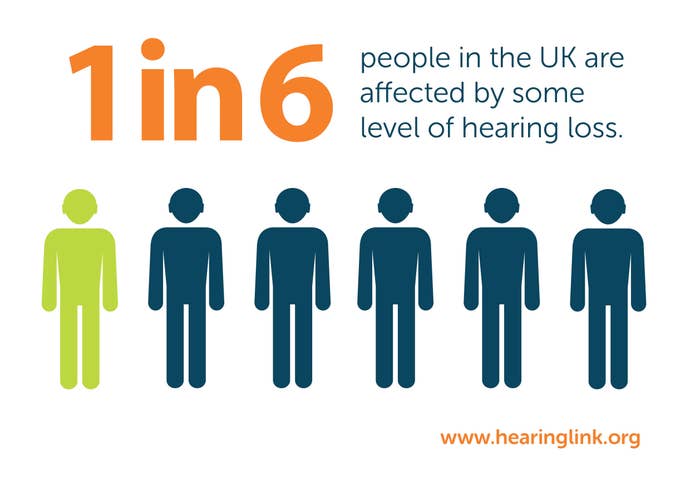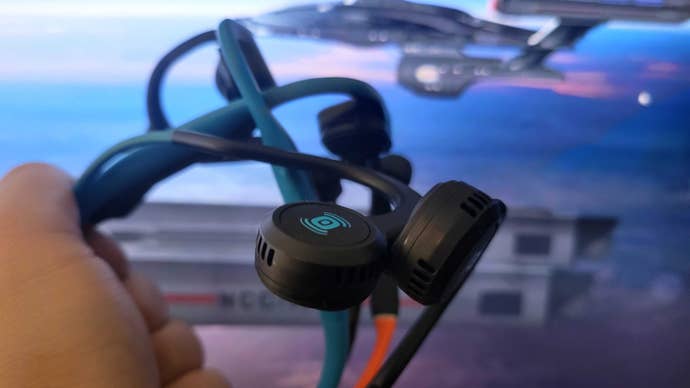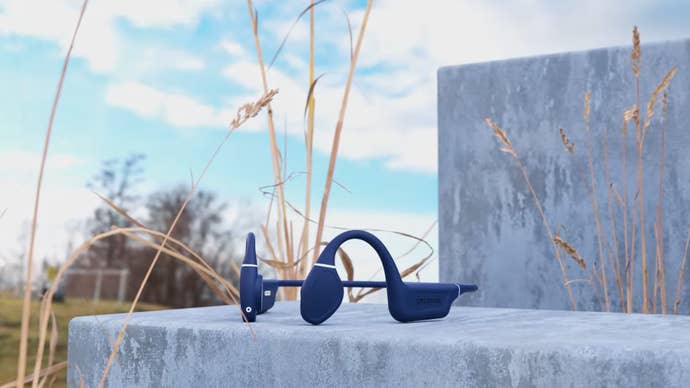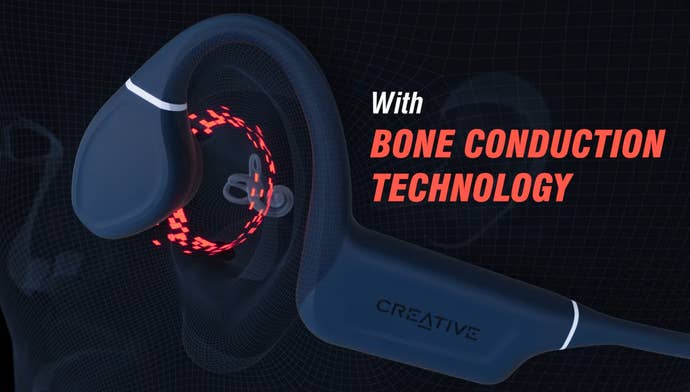Are bone-conducting headsets what middle-aged gamers need to feel alive again?
Creative’s Outlier Free Pro+ has been a revelation for gaming with hearing loss.
This article gets a bit personal in terms of my specific use case, so to spare the unbothered from having to sift through that, here’s the gist:
The Outlier Free Pro+ bone-conduction headset from Creative Labs is a direct contender to the market leader, the Shokz OpenRun PRO, and it’s a comparison it doesn’t fare too badly in. It doesn’t quite have the full-bodied sound of the Shokz, it’s ever so slightly heavier, and the battery life in general day-to-day usage isn’t as robust in this reviewer’s experience, but its inclusion of a Low Latency Mode gives the Creative set an unassailable advantage for gaming, something which most bone-conductors are completely and utterly useless for.
Still here? Cool, thanks. Now, cards on the table: I am definitely not in the usual target market for bone-conducting or “open ear” headphones. They’re specifically aimed at sporty types. Swimmers, who crave a way to listen to music that actually works underwater. Runners, who need a way of listening to their inspirational 90s pop playlists that won’t mask the sound of an EV just before it ploughs into them during the second chorus of Rhythm is a Dancer. And joggers, who go round. And round. And round.
I’m none of those things, but these odd little wiry headsets have become a lifeline for me. They are a personal listening device that doesn’t block the ear canal, instead sending sound directly into your head through your skull just in front of your ears. So, in theory, you can still hear everything going on around you and it almost feels like whatever you’re listening to is coming from inside your head, like the rush of blood when you stand up too quick, or the voices that tell you to kill. This comes with a whole suite of pros and cons which you can summarise as: there’s nothing jammed in your earhole, but you take a hit on sound quality.

The advantages for certain sports are obvious. However, much to the chagrin of my doctor, the only thing I regularly exercise is my right to sit down. I’ve gotten away with this for a long time, but now that I’m about to turn forty my body has started its Inevitable Decline in earnest. Bits of it are going on strike, electing to stop working properly or at all. But at least one of these malfunctions isn’t the fault of management: SSHL, or sudden sensorineural hearing loss, can strike at any age, any time, no matter how many burgers you’ve eaten or loud concerts you’ve attended. One day you can just wake up wholly or partially deaf for no obvious reason. In my case, my frequency response drops off a cliff after about 1500khz on my right side, with everything above that replaced by piercingly loud tinnitus. Like the analogue whine of an old CRT screen, but shoved into one of your ears. Forever.
Several months and four audiologists later, I’m now a member of Britain’s ever growing hearing aid club. SSHL is a common and largely invisible disability, affecting around one in six people in the UK according to the British Academy of Audiology. Anecdotally, cases of it seem to be on the rise since the COVID-19 pandemic – two of my consultants expressed this view. I would, of course, urge you to take that with a massive pinch of salt, and I’d be reluctant to suggest any direct causal link between the virus and SSHL. Compounding this, as we all know, is that googling whether or not covid can cause any imaginable affliction will return a buffet of conflicting answers. And dozens of studies saying “maybe?”.

My personal and completely unresearched theory is that lockdowns and the subsequent rise in work-from-home situations probably caused a massive increase in headphone usage, and that’s generally bad news for ear health. One great and unsung advantage of open-ear headphones is that they don’t cause any itching or ear canal discomfort that other types of headphone can, like those horrid little earbuds you’ve got stashed in your coat pocket. Ew. Yuck. Ew. If you live in Britain, with its epidemic of mouldy flats, you will be aware that blocking up any kind of damp hole will encourage nasty things to grow in it.
So, bone-conduction headsets can be better for your health in several preventative ways: reduced risk of bacterial or fungal infection, reduced risk of stepping out in front of a car, reduced risk of your partner getting a face on because you didn’t respond immediately to a question, that sort of thing. Additionally, one odd (and unexplained) symptom of hearing loss that non-sufferers aren’t aware of is a feeling of fullness in an affected ear, which can make you sensitive to anything that might sit in or on it (including your hearing aid tube, which is a barrel of laughs). Bone-conductors are naturally less likely to exacerbate this phenomenon.

Open-ear headsets have a lot of practical advantages. However, they’re far from a perfect alternative to headphones. If you like lots of bass in your cans, a readjustment will be required. The Outlier Free Pro+, much like all the other sets in this class, doesn’t have the kind of powerful bass response that you might prefer. That’s not to say that the full range of human hearing isn’t represented, only that there’s no boosted bass like you’d expect from normal “disco smile” consumer gear. Mid range frequencies are far more represented in the mix, a tuning that favours the spoken word over crashing, or banging, or indeed: walloping.
The electronics world has been working for a long time on mitigating the latency issues of Bluetooth with regards to lip sync. In most situations nowadays, particularly since the Bluetooth 5.0 standard, your devices will compensate for audio lag by delaying the video by around 200ms or so. Your phones, tablets, TVs, etc will generally do this automatically and imperceptibly for the end user. But that doesn’t cut the mustard when it comes to gaming, where even a slight delay between your button presses and action occurring on screen will completely ruin the feel of a game (unless you’re one of those idiots who plays with motion smoothing turned on, in which case you need spiritual help, not new headphones). The upshot is that most bone-conduction sets aren’t that concerned with latency. The standard Bluetooth protocols are reliable enough to keep Jane Fonda in sync, and that’s fine.
So I’ve been on a fruitless search, for a couple of years now, for a set which has support for the AptX Low Latency codec, or similar. Wired bone-conductors don’t really exist any more, and those you can still get a hold of are either Ali Express jobs that suck, or discontinued Aftershokz models that sound horrid. So when Creative touted a mysterious “low latency mode” on their latest Shokz contender, I wondered if it was too good to be true. It’s not an AptX implementation like you might find on their Sound Blaster JAM V2 on-ear phones (which are, incidentally, an amazing pair of cans for the money, and were my go-to until I got the Outlier Pros), but apparently part of the Bluetooth 5.3 standard, which bodes well for the future in terms of me never having to worry about this niche use case ever again.

I’ve been using the Outlier Free Pro+ for around a month now, primarily for Xbox/PS5 gaming on the big TV but also on the Switch and the Steam Deck. In all cases, the set holds up wonderfully: you simple pair the device as usual, then quick press the function key on the headset four times to activate Low Latency Mode, then enjoy more or less lag free audio in your games without bothering anyone around you or having anything in your ear holes. Which is, as I hope is apparent following the rest of this article, a revelatory experience.
I say “more or less” lag free, because this implementation definitely isn’t as low-latency as wired headphones are, but given how Bluetooth usually compares to electrons tearing down copper wires, it’s incredible. UI sounds and gunshots sound off exactly when you expect them to. Video game cutscenes, which are generally pretty shoddily synced to dialogue at the best of times, play back without any noticeable issues. If you’re a competitive esports gamer who is sensitive to the difference between 120hz and 144hz, you’ll definitely feel that something is off, but then you can tell the difference between a wired controller and a 2.4GHz one, and you probably aren’t a middle-aged husk with buggered hearing, so the point is moot. For us mere mortals, these headphones are for all intents and purposes, capable of perfectly syncing with your TV or gaming device.

In terms of sound quality, as mentioned, they’re not best-in-class. Shokz, their main competition, have been working on this for a long time, and their flagship OpenRun set is the benchmark here with its tight bass rolloff and un-muddied sound stage. They sound as good as a cheap pair of Sony cans, which is about the best you can expect from a device that’s forcing sound waves into your bone marrow. In comparison, the Outlier Free Pro+ just isn’t as good, certainly not when listening to music, where they tend to lose a lot of clarity in the bass and bottom-mids. It struggles to cope with the crowded mix in my go to test track, Sussudio by Phil Collins (shut up), a song that doesn’t sound great if you don’t have decent separation between the punchy bass, phasing pads, and double-tracked vocals.
But when it comes to gaming, the use case we’re most concerned with here, it handles itself perfectly well. In a game with a lot of dynamic range like Starfield, whose soundscape straddles the extremes of howling desolation on desert moons, and close-quarters gun fights with automatic rifles in metal corridors, the whole shebang is rendered with pleasing depth and wide stereo separation. And, of course, while maintaining perfect synchronisation. In Vampire Survivors, a sonic profile that maintains consistent energy with weapon sounds going off over a bedding of rad techno, the experience is once again rendered with more than satisfactory results. Coupled with the fact that these headphones are so light that they often melt away, it can leave you feeling as though the sound is being beamed directly into your brain.

If Shokz ever bother to implement a low latency function, they would probably be the optimal bone-conduction experience when it comes to gaming. But they haven’t, and by the time they do, it’s very possible that Creative will have caught up with them in the fidelity department. They’re already snapping at the heels on that front. So, this recommendation might seem like a niche concern, but gamers are getting older, and so more and more of us are going to experience these issues. An able bodied person is, after all, just someone who isn’t disabled yet. And as millennials hurtle toward their fifties, a significant part of the gaming audience will become more reliant on accessibility technologies to enjoy this hobby. The future seems bright on that front: though there is a lot of work to do, and it requires deliberate effort on the part of platform holders and developers alike to implement things like colorblind modes and support for adaptive controllers.
Something as obscure as sorting out audio latency on bone-conduction sets, which has just sort of happened as a result of the endless march of technology, might not have occurred with ear health in mind. But I’ll take it as a win, and I hope that it becomes an active consideration as things move forward.
If you like the idea of a gaming headset that leaves your ear canals unobstructed, the Outlier Free Pro+ is currently on sale direct from Creative for £89.99, which is £30 less than the RRP. Other similar models are available with varying features, but this one comes with a hearty recommendation from me. I'm wearing them right now, listening to The History of Byzantium podcast while I work, and I can still hear traffic, and dogs barking, and my infant son kicking off about porridge in the next room. Technology is marvellous, innit?
Headset provided for testing by Creative.
Disclaimer: I'm not a medical professional, and the product in question isn't a medical device, nor is it designed to mitigate hearing loss. This is just a product review from my own perspective as someone who finds traditional headphones challenging to use as a result of issues that are adjacent to hearing loss. If you suspect you may have hearing loss, contact your GP.









